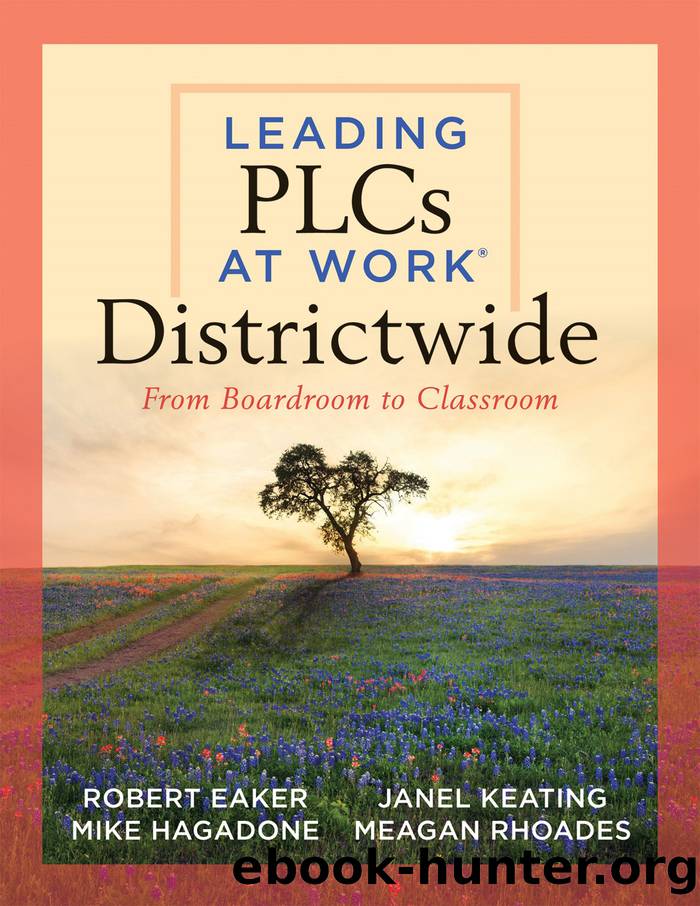Leading PLCs at Work® Districtwide by Eaker Robert;Hagadone Mike;Keating Janel;Rhoades Meagan;

Author:Eaker, Robert;Hagadone, Mike;Keating, Janel;Rhoades, Meagan;
Language: eng
Format: epub
Publisher: Solution Tree
Published: 2021-09-15T00:00:00+00:00
Source: White River School District, 2020. Used with permission.
Figure 2.3: Example showing how an algebra team broke down learning targets.
The district office staff, principals, and building learning coordinators from every building are seated on the perimeter of the team they will observe. This team is seated at a table in the center of the room. We might observe a team deconstructing a standard into learning targets. It could be a team creating the end-of-unit common formative assessment or a team analyzing the results of a formative assessment and forming intervention or extension groups.
During this activity, administrators are observing best practice and can then engage in the benchmarking activity. Through benchmarking, principals reflect on the work they just observed and ask, âDoes the work I just observed reflect the kind of work and quality of work of the school grade-level and content teams at my school?â This fishbowl process also provides an opportunity to give feedback to the observed grade-level or content team. Even a high-performing team has room for improvement.
At the close of every district leadership team meeting, members ask the same questions: âBased on what you learned today, what are you committed to working on or doing with your building leadership team and your school grade-level and content teams? At next monthâs meeting, what product or products are you committed to bring back as evidence of doing the work?â
These commitments could be as simple as an exit slip or a quick email to the superintendent or assistant superintendent. For the next month, every conversation district office leaders have with individual principals is focused on supporting their commitments. When district office leaders visit school buildings, they donât ask, âHowâs it going?â They ask questions and review products and student learning data specifically related to the principalsâ commitments.
District leaders monitor the data with principals, unit by unit. The district office support is directly aligned, helping each principal accomplish the work related to his or her commitments. White River has found value in this strategy of positive peer pressure.
In the White River School District, we believe in learning from each other and in making our work transparentâthe same expectations school leaders have for members of school grade-level and content teams. For example, if you were to attend a district leadership team meeting, you might be quickly engaged in a gallery walk, viewing examples of the commitments from the month before, or you might observe a team of elementary or secondary principals sharing products related to the previous monthâs commitments. Leaders should ask each other probing questions with the goal of continuous improvement. All schoolsâ administrative teams and building learning coordinators should show up to each meeting with evidence of what their building leadership team and school grade-level and content teams accomplished related to the previous monthâs commitment. Principals then have time to discuss the products and evidence and give feedback.
The practices of the district level and principal team within its meetings give leaders the opportunity to look and act like a PLC.
Download
This site does not store any files on its server. We only index and link to content provided by other sites. Please contact the content providers to delete copyright contents if any and email us, we'll remove relevant links or contents immediately.
| ASVAB | GED |
| GRE | NCLEX |
| PRAXIS | SAT |
| See more | Flash Cards |
| Study Guides | Study Skills |
| Workbooks |
Talking to Strangers by Malcolm Gladwell(13052)
The Compound Effect by Darren Hardy(8662)
Tools of Titans by Timothy Ferriss(8046)
Wonder by R. J. Palacio(7814)
The Lover by Duras Marguerite(7673)
A Court of Wings and Ruin by Sarah J. Maas(7459)
The Circle by Dave Eggers(6936)
Deep Work by Cal Newport(6734)
Kaplan MCAT General Chemistry Review by Kaplan(6733)
To All the Boys I've Loved Before by Jenny Han(5659)
Wiseguy by Nicholas Pileggi(5498)
The Body: A Guide for Occupants by Bill Bryson(4758)
1,001 ASVAB Practice Questions For Dummies by Powers Rod(4390)
Eat That Frog! by Brian Tracy(4295)
Cracking the GRE Premium Edition with 6 Practice Tests, 2015 (Graduate School Test Preparation) by Princeton Review(4116)
Pre-Suasion: A Revolutionary Way to Influence and Persuade by Robert Cialdini(4046)
Barron's AP Biology by Goldberg M.S. Deborah T(4014)
ACT Math For Dummies by Zegarelli Mark(3896)
Kaplan MCAT Organic Chemistry Review: Created for MCAT 2015 (Kaplan Test Prep) by Kaplan(3863)
